
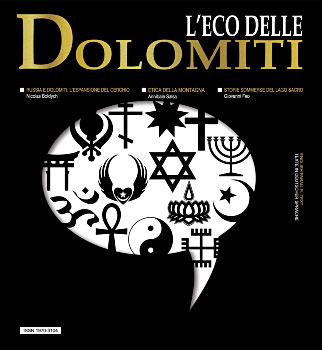
In anticipation of the extraordinary appointment with the 2014 Sochi Olympics and to emphasise the importance and the attention placed upon it by the central Russian authorities, the Press Office of the Presidency of the Russian Federation has decided to intervene directly to promote the event in Alto Adige (opting for three particularly important locations, namely Bolzano, Brunico and Corvara, the birthplace par excellence of all the skiing disciplines both Italian and worldwide.
The organisers have called upon the help of the Honorary Consul of the Russian Federation in Bolzano, Dr. Bernhard Kiem, who, along with his team, is organising a number of photographic exhibitions on the splendid region of Sochi. He also availing himself of the support of the fortnightly publication in Russian “Nasha Gazeta” (Our Gazzette) (the only Russian language newspaper in Italy) that will act as a channel of communication for the entire period of the exhibition.
It all gets under way on 19 November of this year at Bolzano Railway Station, where the photographic exhibition is to be held in concurrence with the Christmas flea markets in the central hall of the building, running until 23 December. The photos depict the locations where the Winter Olympic Games of 2014 are to be staged. A succession of different shots of athletes in action on the ski slopes are not the only feature of the exhibition which is made all the more interesting by beautiful images of Sochi and its breathtaking panoramas.
A second photographic exhibition opens in Corvara on 1 December at the downhill Station of the Badia chair lift and runs until 27 December.
The final stop for the exhibition will be Brunico, in the municipal town square where ten enormous cubes will act as gigantic photographs displaying forty images to passers by that depict Sochi from a tourism perspective.
These exhibitions will transmit visually, to those that are not yet aware of them, the beauties and attractions that are Sochi. Not just a winter tourist location, but also an attractive seaside tourist centre, with its long beaches, fashionable venues and the sea with its intense blue colour, perfect for those who both love and practise the sport of surfing. Featuring predominantly, however, will be the images of the mountains and the ski runs that will captivate the observant eye of the winter skiing enthusiast with their fascination.
The exhibition in Bolzano
(19 November – 23 December)
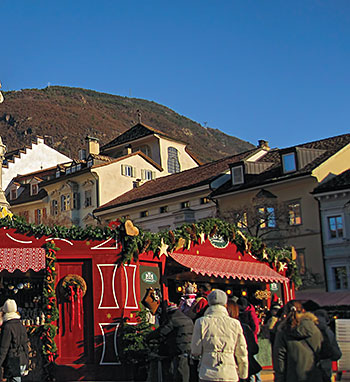
The exhibition has been arranged to run concurrently with the famous Christmas flea markets and on the back of the skiing season. The Christmas flea market in Bolzano in Alto Adige is the largest in Italy. With a unique charm all of its own, this market has for almost twenty years attracted hoards of visitors every year to Piazza Walther, magnificently decked out for Advent.
For about a month the streets and alleyways of Alto Adige’s regional capital is swamped by the atmosphere of Christmas and the brightness of romantic lamps and flickering candles, which for a moment envelop it in a magic light.
This year's edition of Bolzano’s Christmas flea market is held under the banner of “A meeting of cultures” (Incontro di cultura). A coming together of the Russian Federation and Bolzano that is designed to be of use not just in strengthening the bonds of friendship that already exist between the two but also, by means of the exhibition, to serve as a good omen for the Olympic Games. Christmas, at least for those of us who love the Dolomites and their echoes, is precisely this!
The exhibition in Corvara
at the downhill station of the Badia chair lift
(1 – 27 December 2012)
The choice of Badia is not just a casual one. A holiday in Upper Badia helps people to get to know and appreciate a different way of living, one that is based on serenity and physical and spiritual well being in a world where new trends, old traditions, sport, culture, the high spirits of the celebrations and the peace of moments dedicated to oneself are all of equal worth.
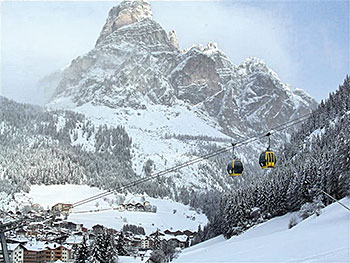
Its value is enhanced by the Dolomites and the rich natural heritage of the six small towns of the Upper Badia, an age-old farming-artisan culture and a gastronomy that is rich in all its varied aspects, from agritourism to gourmet cooking. The care and love of one’s own home and the environment that surrounds it, highlights a marked sense of hospitality. The excellently stocked stores offer the most prestigious brand names, regional specialities and items of local craftsmanship. Not to mention the havens of wellness that know to organise advanced, tailor-made programs for everyone.
The skiing areas in the Dolomite Superski district, which includes Upper Badia, are to be found in areas that have a natural blanket of snow, at altitudes of between 1,400 and 3,269 metres. According to the experts, the extremely low levels of humidity render the snow particularly powdery so that skiing can continue from November through to April.
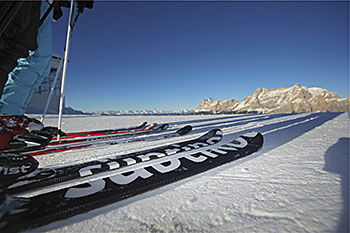
For lovers of skiing and snowboarding Upper Badia and the entire skiing area of the Dolomites, with over 1,200km of ski runs, fresh snow, blue sky and wonderfully sunny days, are a veritable winter paradise, formed 200 million years ago by the primordial sea. There was a time when the highest and best known peaks of the Dolomites were in fact atolls.
The skiing area ensures the best possible conditions throughout the entire winter. The lift facilities are comfortable, fast and safe and the vastness of the skiing area allows the sport to be enjoyed in total tranquillity and safety.
Breathtaking panoramic views over the Dolomites’ most beautiful peaks, the wide, sunny and perfectly prepared ski runs, wonderful sun-drenched days, welcoming shelters and refined restaurants high up in the mountains all come together to make Upper Badia a skiing area for connoisseurs.
What better place than Badia therefore, for exhibiting the forty images of Sochi! And it is here that we find all those who love and practise winter sports and who, with their expert eye, will be better able to appreciate the extraordinary beauty of Sochi through these images and to weigh up the possibility of attending the next Winter Olympic Games as spectators.
The exhibition in Brunico
(27 December 2012 – 2 February 2013)
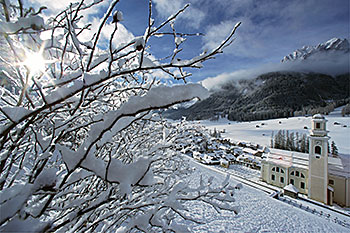
Why Brunico? Because Brunico considers itself a city of sport. The local council understands the high social value of sporting activity, intended as the culture of a varied and diverse use of free time in physical activities for all age groups, as well as being a contributory factor in the education and training of the young.
Art and concerts, music and theatre, celebrations and events: from a cultural perspective the city of Brunico is undoubtedly the undisputed cultural centre of the Pusteria Valley. The local authority supports the constant cultural commitment of individual residents and the numerous associations and cultural initiatives that enhance in a multitude of ways the life of the city and its surrounding hamlets.
Dedicated to the people of the mountains, the Castle of Brunico stands in the Pusteria Valley, within the city boundary. The project is interactive and is a place for gathering and cultural exchanges between the local rural population and guests visiting from the other mountain regions of the world.
The Caste of Brunico, which like the city is named after it founder, is enclosed by a massive wall with towers. The castle is still well preserved and until 2004, with the exception of a brief period, was owned by the Bishop of Bressanone (Episcopal authorities).
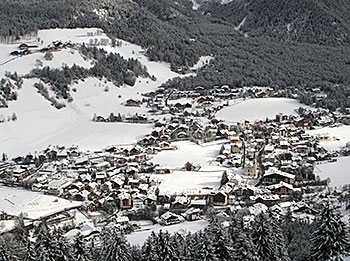
In Brunico and throughout the entire Pusteria Valley tourism represents a strong economic factor. Tourism is described by many as the most important economic driving force or powerhouse behind the local economy.
This is also because many other sectors such as handicrafts, gastronomy, commerce as well as those of the service providers are directly or indirectly influenced by it.
The city of Brunico, along with the other neighbouring municipalities, is a member of the Plan de Corones Holiday Area. The Plan de Corones is the mountain of Brunico which, in winter, is transformed into the driving force and powerhouse behind its tourist economy. The Plan de Corones has always formed part of the skiing Dolomites Superski series. Offering at least 450 ski-lifts and 1200 kilometers of pistes with snowfall scheduled in twelve of the Dolomite valleys, the consortium is positioned at the peak of world ski tourism. The Dolomites Superski area includes Sellaronda, Alta Badia, La Marmolada, Val Gardena and Val di Fassa. Dolomite Superski's fifteen “Skitour” offerings – ski tours focused on different themes – are famous. At Plan de Corones, the Legends of the Dolomites reign supreme.
To conclude, the Alps and the Dolomites in particular are ideally close to Sochi that is not just a centre of attractions in the most varied sectors of tourism, but is above all, for those impassioned lovers of the snow, a new destination to be discovered, and why not? … perhaps even to somewhere to go and ski!
See you at Sochi 2014!